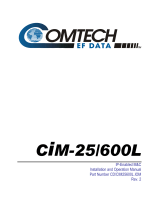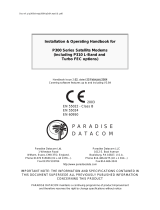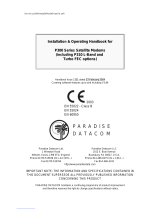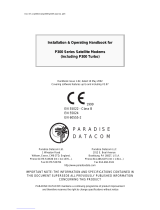Page is loading ...

Part Number MN/CDM600L.IOM Revision 2
IMPORTANT NOTE: The information contained in this document supersedes all previously published
information regarding this product. Product specifications are subject to change without prior notice.
CD
M
-
600L
Open Network Satellite Modem (2.4 kbps – 20 Mbps
)
Installation and Operation Manual
For Firmware Version 1.3.0 or hi
g
he
r
(
see New in this Release
–
Section 1.5
)


s:\tpubs\manuals\released_word\modems\cdm600l_rev2\errata\mn-cdm600l-ea2.doc
1
Errata A
Comtech EF Data Documentation Update
Subject:
Changes to 15.7 Miscellaneous
Date:
March 30, 2005
Original Document
Part Number/Rev:
MN/CDM600L.IOM Rev 2
Errata
Part Number:
MN/CDM600L.EA2
This information will be incorporated into the next revision.
Change Specifics:
Changed from:
Dimensions
1U high, 12 inches (305 mm) deep
To:
Dimensions
1U high, 18 inches (457 mm) deep
Note: The dimensional envelope drawing in Chapter 4 is correct.


s:\tpubs\manuals\released_word\modems\cdm600l_rev2\errata\errata b.doc
1
Errata B
Comtech EF Data Documentation Update
Subject:
Changes to power consumption and fuse information
Date:
April 25, 2005
Document:
CDM-600L Satellite Modem Installation and Operation Manual,
Rev.2, dated March 9, 2005
Part Number:
MN/CDM600L.EB2
Collating Instructions:
Attach this page to page x
Comments:
This information will be incorporated into the next revision.
Change Specifics:
F
USES
The CDM-600L Satellite Modem is fitted with two fuses, one each for line and neutral
connections. These are contained within the body of the IEC power connector, behind a small
plastic flap.
• Use T5.0A, Slow blow fuse, P/N FS/5ASB-IEC.
The DC CDM-600L Satellite Modem is fitted with two fuses – one each for positive and
negative connections. These are contained within the body of the power inlet , behind a
small plastic flap.
•
For 38 to 60 VDC operation, use T2.0A, 20mm fuses if the modem has no BUC
power supply.
• For 38 to 60 VDC operation, use T8.0A, 20 mm fuses if the modem is fitted with
internal BUC power supply.
IMPORTANT
For continued operator safety, always replace the fuses with the
correct type and rating.


s:\tpubs\manuals\released_word\modems\cdm600l_rev2\errata\errata c.doc
1
Errata C
Comtech EF Data Documentation Update
Subject:
Change AUPC Target Eb/No Limit
Date:
November 23, 2005
Document:
CDM-600L Revision 2, Open Network Satellite Modem, Installation
and Operation Manual, dated March 9, 2005
Part Number:
MN/CDM600L.EC2
Collating Instructions:
Attach this page to page 16-23
Comments:
The following changes affects the values shown on page 6-10 and 16-23.
Change Specifics:
Change to AUPC Target Eb/No Parameter
Since Revision 2 of the CDM-600L Manual was published, the range of the value of target Eb/No has
been increased. Effective in firmware version 1.4.0 and subsequent:
• Previously the maximum value was 9.9 dB
• New maximum value is 14.9 dB.
This affects the front panel and the remote control, refer to the remote control command table for more
detail.

s:\tpubs\manuals\released_word\modems\cdm600l_rev2\errata\errata c.doc
2
AUPC
Parameters
APP=
6 bytes Command or Query.
Defines AUPC operating parameters. Has the form abc.cd,
where:
a=Defines action on max. power condition.
(0=do nothing, 1=generate Tx alarm)
b=Defines action on remote demod unlock.
(0=go to nominal power, 1=go to max power)
c.c=target Eb/No value, for remote demod, from 0.0 to
14.9 dB, where numbers above 9.9 use hex
representation for the 1 st character, ie 14.9 is
coded as E.9.
d =Max increase in Tx Power permitted, from
0.0 to 9.0 dB
Example: APP=015.67 (Sets no alarm, max power, 5.6 dB
target Eb/No and 7 dB max power increase.
APP=
APP?
APP*
APP#
APP? APP=abc.cd
(see description of
arguments)

CDM-600L
Open Network Satellite Modem (2.4 kbps – 20 Mbps)
Installation and Operation Manual
For Firmware Version 1.3.0 or higher
(see New in this Release – Section 1.5)
Part Number MN/CDM600L.IOM
Revision 2
March 9, 2005
Copyright © Comtech EF Data, 2003. All rights reserved. Printed in the USA.
Comtech EF Data, 2114 West 7th Street, Tempe, Arizona 85281 USA, 480.333.2200, FAX: 480.333.2161
Comtech EF Data is an ISO 9001
Registered Company.

ii

iii
Table of Contents
ABOUT THIS MANUAL .............................................................................................................. IX
CONVENTIONS AND REFERENCES ....................................................................................... IX
RECOMMENDED STANDARD DESIGNATIONS ....................................................................... X
ELECTRICAL SAFETY................................................................................................................ X
TELECOMMUNICATIONS TERMINAL EQUIPMENT DIRECTIVE........................................... XII
EMC (ELECTROMAGNETIC COMPATIBILITY) ....................................................................... XII
WARRANTY POLICY ............................................................................................................... XIV
CHAPTER 1.
INTRODUCTION .............................................................................................1–1
1.1 STANDARD FEATURES ...............................................................................................1–2
1.1.1 AUPC ......................................................................................................................1–2
1.1.2 Software – Flash Upgrading ...................................................................................1–2
1.1.3 Verification ..............................................................................................................1–3
1.1.4 Data Interfaces........................................................................................................1–3
1.2 MAJOR ASSEMBLIES...................................................................................................1–3
1.3 FAST OPTIONS AND HARDWARE OPTIONS .............................................................1–4
1.3.1 FAST Accessible Options .......................................................................................1–5
1.3.2 FAST System Theory..............................................................................................1–5
1.3.3 Implementation .......................................................................................................1–6
1.3.4 Hardware Options ...................................................................................................1–6
1.3.5 Supporting Hardware and Software........................................................................1–7
1.4 COMPATIBILITY............................................................................................................1–7
1.5 NEW IN THIS RELEASE ...............................................................................................1–7
CHAPTER 2. INSTALLATION ..............................................................................................2–1
2.1 UNPACKING..................................................................................................................2–1
2.2 MOUNTING....................................................................................................................2–2
2.3 CONFIGURATION .........................................................................................................2–4
2.4 SELECT INTERNAL IF LOOP .......................................................................................2–4
2.5 CONNECT EXTERNAL CABLES ..................................................................................2–4
CHAPTER 3. FUNCTIONAL DESCRIPTION........................................................................3–1
CHAPTER 4. PHYSICAL DESCRIPTION .............................................................................4–1
4.1 INTRODUCTION............................................................................................................4–1
4.2 FRONT PANEL ..............................................................................................................4–1
4.3 REAR PANEL ................................................................................................................4–2
4.4 DIMENSIONAL ENVELOPE ..........................................................................................4–6
CHAPTER 5. CONNECTOR PINOUTS................................................................................5–1

CDM-600L Satellite Modem Revision 2
Preface MN/CDM600.IOM
iv
5.1 CONNECTOR OVERVIEW............................................................................................5–1
5.2 OVERHEAD INTERFACE CONNECTOR (P3A) ...........................................................5–3
5.3 DATA INTERFACE CONNECTOR (P3B) ......................................................................5–4
5.4 AUDIO INTERFACE CONNECTOR (P4A) ....................................................................5–5
5.5 REMOTE CONTROL INTERFACE CONNECTOR (P4B).............................................5–5
5.6 IDR BACKWARD ALARMS CONNECTOR (P5A) .........................................................5–6
5.7 AUXILIARY SERIAL CONNECTOR (P6).......................................................................5–6
5.8 BALANCED G.703 INTERFACE CONNECTOR (P7)....................................................5–7
5.9 BNC CONNECTORS .....................................................................................................5–7
5.10 UNIT ALARMS (P5B) .................................................................................................5–8
5.11 AC POWER CONNECTOR OPTION .........................................................................5–8
5.12 DC POWER CONNECTOR OPTION .........................................................................5–9
5.13 GROUND CONNECTOR ...........................................................................................5–9
CHAPTER 6. FRONT PANEL OPERATION.........................................................................6–1
6.1 DESCRIPTION...............................................................................................................6–1
6.2 OPENING SCREEN.......................................................................................................6–5
6.3 MAIN MENU...................................................................................................................6–5
6.3.1 CONFIG ..................................................................................................................6–6
6.3.2 TEST.....................................................................................................................6–28
6.3.3 INFORMATION.....................................................................................................6–30
6.3.4 MONITOR .............................................................................................................6–34
6.3.5 STORE/LOAD.......................................................................................................6–39
6.3.6 UTILITIES .............................................................................................................6–40
6.3.7 ODU ......................................................................................................................6–42
6.3.8 FAST.....................................................................................................................6–46
CHAPTER 7. FORWARD ERROR CORRECTION OPTIONS.............................................7–1
7.1 INTRODUCTION............................................................................................................7–1
7.2 VITERBI .........................................................................................................................7–1
7.3 SEQUENTIAL ................................................................................................................7–2
7.4 REED-SOLOMON OUTER CODEC ..............................................................................7–3
7.5 TRELLIS CODING (FAST OPTION)..............................................................................7–5
7.6 TURBO PRODUCT CODEC (HARDWARE OPTION)...................................................7–6
7.7 TPC AND LOW DENSITY PARITY CHECK (LDPC) CODING......................................7–6
7.7.1 Introduction .............................................................................................................7–6
7.7.2 LDPC versus TPC...................................................................................................7–7
7.7.3 End-to-End Processing Delay.................................................................................7–9
7.8 UNCODED OPERATION (NO FEC) ............................................................................7–11
CHAPTER 8. OFFSET QPSK OPERATION .........................................................................8–1
CHAPTER 9. OPEN NETWORK OPERATIONS ..................................................................9–1

CDM-600L Satellite Modem Revision 2
Preface MN/CDM600.IOM
v
9.1 INTRODUCTION............................................................................................................9–1
9.2 IBS .................................................................................................................................9–1
9.2.1 IBS Clock/data recovery and De-jitter.....................................................................9–2
9.2.2 IBS Framing ............................................................................................................9–2
9.2.3 IBS Engineering Service Channel...........................................................................9–2
9.2.4 IBS Scrambling .......................................................................................................9–2
9.3 DROP AND INSERT ......................................................................................................9–2
9.3.1 D&I Primary Data Interfaces ...................................................................................9–3
9.3.2 D&I Framing............................................................................................................9–3
9.4 IDR .................................................................................................................................9–4
9.4.1 IDR Primary Data Interfaces ...................................................................................9–5
9.4.2 IDR Engineering Service Channel ..........................................................................9–5
CHAPTER 10. CLOCK MODES AND DROP AND INSERT (D&I) .....................................10–1
10.1 TRANSMIT CLOCKING ...........................................................................................10–1
10.1.1 Internal Clock ........................................................................................................10–1
10.1.2 TX Terrestrial Clock ..............................................................................................10–2
10.1.3 RX Loop-Timed, RX=TX .......................................................................................10–2
10.1.4 RX Loop-Timed, RX<>TX (Asymmetric Loop Timing) ..........................................10–2
10.1.5 External Clock.......................................................................................................10–2
10.1.6 External Reference ...............................................................................................10–3
10.2 RECEIVE CLOCKING ..............................................................................................10–3
10.2.1 Buffer Disabled (RX Satellite) ...............................................................................10–3
10.2.2 Buffer Enabled, TX=RX (TX Terrestrial or External Clock) ...................................10–3
10.2.3 Buffer Enabled, RX<>TX (TX Terrestrial or External Clock).................................10–3
10.3 X.21 NOTES.............................................................................................................10–3
10.4 DROP AND INSERT ................................................................................................10–6
10.5 FRAME FORMATS ..................................................................................................10–6
10.6 TIME SLOT SELECTION .........................................................................................10–7
10.7 DROP AND INSERT CLOCKING.............................................................................10–8
10.8 RX BUFFER CLOCK = INSERT (D&I ONLY) ..........................................................10–9
10.9 SINGLE-SOURCE MULTIPLE MODEMS ................................................................10–9
CHAPTER 11. EDMAC CHANNEL ......................................................................................11–1
11.1 THEORY OF OPERATION ......................................................................................11–1
11.2 M&C CONNECTION ................................................................................................11–2
11.3 SETUP SUMMARY ..................................................................................................11–3
11.4 DROP & INSERT ++ ................................................................................................11–4
CHAPTER 12. AUTOMATIC UPLINK POWER CONTROL................................................12–1
12.1 INTRODUCTION ......................................................................................................12–1
12.2 SETTING AUPC PARAMETERS .............................................................................12–2
12.2.1 AUPC Target Eb/No..............................................................................................12–2
12.2.2 Max Range, AUPC................................................................................................12–2
12.2.3 Alarm, AUPC.........................................................................................................12–3

CDM-600L Satellite Modem Revision 2
Preface MN/CDM600.IOM
vi
12.2.4 Demod Unlock ......................................................................................................12–3
12.3 COMPENSATION RATE..........................................................................................12–3
12.4 MONITORING ..........................................................................................................12–4
CHAPTER 13. ESC++...........................................................................................................13–1
13.1 INTRODUCTION ......................................................................................................13–1
13.2 OVERHEAD DETAILS .............................................................................................13–1
13.3 AVAILABLE BAUD RATES ......................................................................................13–2
13.4 CONFIGURATION ...................................................................................................13–2
13.5 EFFECT ON EB/NO PERFORMANCE ....................................................................13–2
CHAPTER 14. FLASH UPGRADING ...................................................................................14–1
CHAPTER 15. SUMMARY OF SPECIFICATIONS ..............................................................15–1
15.1 MODULATOR...........................................................................................................15–1
15.2 DEMODULATOR......................................................................................................15–4
15.3 AUTOMATIC UPLINK POWER CONTROL .............................................................15–9
15.4 DATA INTERFACES ................................................................................................15–9
15.5 DATA RATE RANGES ...........................................................................................15–10
15.6 FRAMING SUMMARY............................................................................................15–11
15.7 MISCELLANEOUS .................................................................................................15–11
15.8 APPROVALS..........................................................................................................15–12
CHAPTER 16. REMOTE CONTROL ....................................................................................16–1
16.1 INTRODUCTION ......................................................................................................16–1
16.2 RS-485 .....................................................................................................................16–1
16.3 RS-232 .....................................................................................................................16–2
16.4 BASIC PROTOCOL..................................................................................................16–2
16.5 PACKET STRUCTURE ............................................................................................16–3
16.5.1 Start Of Packet......................................................................................................16–3
16.5.2 Address.................................................................................................................16–3
16.5.3 Instruction Code....................................................................................................16–4
16.5.4 Instruction Code Qualifier .....................................................................................16–4
16.5.5 Message Arguments .............................................................................................16–5
16.5.6 End Of Packet.......................................................................................................16–5
16.6 REMOTE COMMANDS............................................................................................16–6
16.6.1 TX Remote Commands ........................................................................................16–7
16.6.2 RX Remote Commands ......................................................................................16–13
16.6.3 Unit Remote Commands.....................................................................................16–20
16.6.4 Query Commands...............................................................................................16–27
16.6.5 Bulk Commands..................................................................................................16–33
16.6.6 BUC Commands .................................................................................................16–36
16.6.7 LNB Commands..................................................................................................16–39

CDM-600L Satellite Modem Revision 2
Preface MN/CDM600.IOM
vii
CHAPTER 17. BUC FSK COMMUNICATIONS ...................................................................17–1
17.1 INTRODUCTION ......................................................................................................17–1
17.1.1 Transmission Interface..........................................................................................17–2
17.2 MESSAGE STRUCTURE.........................................................................................17–2
17.2.1 Command Message Structure (CDM-600L to BUC).............................................17–2
17.2.2 Response Message Structure (BUC to CDM-600L) .............................................17–3
17.3 BUC POWER CLASS...............................................................................................17–3
17.4 BUC OUTPUT POWER LEVELING .........................................................................17–4
CHAPTER 18. DST SETUP..................................................................................................18–1
18.1 INITIAL OPERATION ...............................................................................................18–1
18.1.1 Prior to Turning On Power ....................................................................................18–1
18.1.2 Initial Power Up – Modem Only ............................................................................18–2
18.2 LO, MIX AND SPECTRUM (INVERSION) SETTINGS.............................................18–3
18.3 APPLYING POWER TO THE BUC ..........................................................................18–4
18.4 INITIAL OPERATION OF THE MODEM WITH THE BUC AND LNB.......................18–5
APPENDIX A. CABLE DRAWINGS ...................................................................................... A–1
APPENDIX B. EB/NO MEASUREMENT ............................................................................... B–1
APPENDIX C. FAST ACTIVATION PROCEDURE............................................................... C–1
C.1 INTRODUCTION........................................................................................................... C–1
C.2 ACTIVATION PROCEDURE......................................................................................... C–1
C.2.1 Serial Number ........................................................................................................ C–1
C.2.2 View currently installed features ............................................................................ C–2
C.2.3 Enter Access Codes .............................................................................................. C–2
INDEX .......................................................................................................................I–1
Figures
Figure 1-1. CDM-600L L-Band Satellite Modem......................................................................................1–1
Figure 2-1. Installation of the Optional Mounting Bracket, KT/6228-2.....................................................2–3
Figure 3-1. CDM-600L Modem Block Diagram........................................................................................3–2
Figure 4-1. CDM-600L Front Panel..........................................................................................................4–1
Figure 4-2. CDM-600L Rear Panel ..........................................................................................................4–2
Figure 4-3. CDM-600L Dimensional Envelope .........................................................................................4–6
Figure 6-1. Front Panel View ...................................................................................................................6–1
Figure 6-2. Keypad................................................................................................................................... 6–3
Figure 6-3. CDM-600L Menu Trees .........................................................................................................6–4
Figure 6-4. Loopback Modes .................................................................................................................6–29
Figure 7-1. Viterbi Decoding ..................................................................................................................7–13
Figure 7-2. Sequential Decoding 64 kbps.............................................................................................7–14
Figure 7-3. Sequential Decoding 1024 kbps..........................................................................................7–15
Figure 7-4. Sequential Decoding 2048 kbps..........................................................................................7–16

CDM-600L Satellite Modem Revision 2
Preface MN/CDM600.IOM
viii
Figure 7-5. Viterbi with concatenated R-S Outer Code .........................................................................7–17
Figure 7-6. Sequential with concatenated R-S Outer Code................................................................... 7–18
Figure 7-7. 8-PSK/TCM Rate 2/3 with and without concatenated Reed-Solomon Outer Code ............7–19
Figure 7-8. Comtech EF Data Turbo Product Codec Rate 3/4 QPSK/OQPSK, 8-PSK and 16-QAM..7–20
Figure 7-9. Comtech EF Data Turbo Product Codec Rate 7/8 QPSK/OQPSK, 8-PSK and 16-QAM..7–21
Figure 7-10. Rate 1/2 QPSK, Rate 0.95 QPSK and Rate 0.95 8-PSK ..................................................7–22
Figure 7-11. Rate 21/44 BPSK and Rate 5/16 BPSK Turbo.................................................................. 7–23
Figure 7-12. 16-QAM Viterbi, Rate 3/4 and Rate 7/8 with 220,200 Reed-Solomon Outer Code ..........7–24
Figure 7-13. Differential Encoding - No FEC, No Scrambling................................................................ 7–25
Figure 7-14. LDPC, Rate 1/2, BPSK, (O)QPSK.....................................................................................7–26
Figure 7-15. LDPC, Rate 2/3, (O)QPSK/8-PSK/8-QAM ........................................................................ 7–27
Figure 7-16. LDPC, Rate 3/4, (O)QPSK/8-QAM....................................................................................7–28
Figure 7-17. LDPC, Rate 3/4, 8-PSK / 8-QAM.......................................................................................7–29
Figure 10-1 Tx Clock Modes..................................................................................................................10–4
Figure 10-2 Rx Clock Modes .................................................................................................................10–5
Figure 10-3 Supported T1 and E1 Framing Formats.............................................................................10–6
Figure 10-4 Drop and Insert Clocking ....................................................................................................10–8
Figure 10-5. Single-Source Multiple Modems (Looming) .................................................................... 10–10
Tables
Table 5-1. CDM-600L External Connections ........................................................................................... 5–2
Table 5-2. Overhead Interface Connector Pin Assignments ................................................................... 5–3
Table 5-3. Data Interface Connector Pin Assignments............................................................................5–4
Table 5-4. Audio Interface Connector Pin Assignments ..........................................................................5–5
Table 5-5. Remote Control Interface Connector Pin Assignments......................................................... 5–5
Table 5-6. IDR Alarm Interface Connector Pin Assignments.................................................................. 5–6
Table 5-7. Auxiliary Serial Connector (USB Type B Socket) ................................................................... 5–6
Table 5-8. Balanced G.703 Interface Connector Pin Assignments .........................................................5–7
Table 5-9. BNC Connectors .....................................................................................................................5–7
Table 5-10. Alarm Interface Connector Pin Assignments.......................................................................5–8
Table 6-1. Front Panel LED Indicators..................................................................................................... 6–2
Table 7-1. Viterbi Decoding Summary .....................................................................................................7–2
Table 7-2. Sequential Decoding Summary ..............................................................................................7–3
Table 7-3. Concatenated Reed-Solomon Coding Summary ...................................................................7–4
Table 7-4. 8-PSK/TCM Coding Summary................................................................................................7–5
Table 7-5. Available TPC and LDPC Modes............................................................................................7–8
Table 7-6. Turbo Product Coding Processing Delay Comparison ........................................................... 7–9
Table 7-7. TPC and LDPC Summary.....................................................................................................7–11

ix
Preface
About this Manual
This manual provides installation and operation information for the Comtech EF Data
CDM-600L satellite modem. This is a technical document intended for earth station
engineers, technicians, and operators responsible for the operation and maintenance of
the CDM-600L.
Conventions and References
Metric Conversion
Metric conversion information is located on the inside back cover of this manual. This
information is provided to assist the operator in cross-referencing English to Metric
conversions.
Cautions and Warnings
IMPORTANT
Indicates information critical for proper equipment function.
WARNING
WARNING indicates a potentially hazardous situation that, if not avoided,
could result in death or serious injury.

CDM-600L Satellite Modem Revision 2
Preface MN/CDM600.IOM
x
Reporting Comments or Suggestions Concerning this Manual
Comments and suggestions regarding the content and design of this manual will be
appreciated. To submit comments, please contact the Comtech EF Data Technical
Publications Department: [email protected]
Recommended Standard Designations
Recommended Standard (RS) is equivalent to the Electronic Industries Association (EIA)
designation. Either designation is acceptable. However, Comtech EF Data has decided
that only one reference designator, either RS or EIA, may be used in a manual.
Electrical Safety
The CDM-600L Modem has been shown to comply with the following safety standard:
• EN 60950: Safety of Information Technology Equipment, including electrical
business machines
The AC powered equipment is rated for operation over the range 100 - 240 volts. It has a
maximum power consumption of 290 watts including maximum BUC power supply load,
and draws a maximum of 2.9 A. The DC powered version is rated for operation over the
range of 38 to 60 VDC input.
Fuses
The AC CDM-600L is fitted with two fuses - one each for line and neutral connections.
These are contained within the body of the IEC power inlet connector, behind a small
plastic flap.
• For 115 and 230 volt AC operation, use T3.15A, 20mm fuses.
The DC CDM-600L is fitted with two fuses – one each for positive and negative
connections. These are contained within the body of the power inlet , behind a small
plastic flap.
• For 38 to 60 VDC operation, use T3.15A, 20mm fuses if the modem has no BUC
power supply.
For 38 to 60 VDC operation, use T8.0A, 20 mm fuses if the modem is fitted with
internal BUC power supply.
IMPORTANT
For continued operator safety, always replace the fuses with the
correct type and rating.

CDM-600L Satellite Modem Revision 2
Preface MN/CDM600.IOM
xi
Environmental
The CDM-600L must not be operated in an environment where the unit is exposed to
extremes of temperature outside the ambient range 0 to 50°C (32° to 122°F),
precipitation, condensation, or humid atmospheres above 95% RH, altitudes (un-
pressurised) greater than 2000 metres, excessive dust or vibration, flammable gases,
corrosive or explosive atmospheres.
Operation in vehicles or other transportable installations that are equipped to provide a
stable environment is permitted. If such vehicles do not provide a stable environment,
safety of the equipment to EN60950 may not be guaranteed.
Installation
AC Modem Installation:
The installation and connection to the line supply must be made in compliance to local or
national wiring codes and regulations.
The CDM-600L is designed for connection to a power system that has separate ground,
line and neutral conductors. The equipment is not designed for connection to power
system that has no direct connection to ground.
The CDM-600L is shipped with a line inlet cable suitable for use in the country of
operation. If it is necessary to replace this cable, ensure the replacement has an equivalent
specification. Examples of acceptable ratings for the cable include HAR, BASEC and
HOXXX-X. Examples of acceptable connector ratings include VDE, NF-USE, UL, CSA,
OVE, CEBEC, NEMKO, DEMKO, BS1636A, BSI, SETI, IMQ, KEMA-KEUR and
SEV.
International Symbols:
Symbol Definition Symbol Definition
~
Alternating Current
Protective Earth
Fuse
Chassis Ground
DC Modem Installation:
The DC input CDM-600L is connected to a nominal 48 VDC prime power source. The
DC input is isolated from the chassis and from the DC output to the BUC if equipped
with internal BUC power supply. The chassis may be connected to a local system ground

CDM-600L Satellite Modem Revision 2
Preface MN/CDM600.IOM
xii
using a separate wire to the ground stud on the back of the chassis. Since the DC input is
isolated, either the positive or the negative side of the DC input may be common with
local ground. Labeling on the back of the chassis indicates the positive and negative
terminals of the input power socket.
The modem is supplied with a 2-wire power cable (CEFD part number CA/WR10327-1)
with one end terminated with a connector that mates with the modem input power socket.
Positive DC input is on the red wire, while negative DC input is on the black wire. The
DC input connector is Molex PN 03-12-1026 with Molex PN 08-12-1222 pins.
Telecommunications Terminal Equipment Directive
In accordance with the Telecommunications Terminal Equipment Directive 91/263/EEC,
this equipment should not be directly connected to the Public Telecommunications
Network.
EMC (Electromagnetic Compatibility)
In accordance with European Directive 89/336/EEC, the CDM-600L Modem has been
shown, by independent testing, to comply with the following standards:
Emissions: EN 55022 Class B - Limits and methods of measurement of radio
interference characteristics of Information Technology Equipment.
(Also tested to FCC Part 15 Class B)
Immunity: EN 50082 Part 1 - Generic immunity standard, Part 1: Domestic,
commercial and light industrial environment.
Additionally, the CDM-600L has been shown to comply with the following standards:
EN 61000-3-2 Harmonic Currents Emission
EN 61000-3-3 Voltage Fluctuations and Flicker
EN 61000-4-2 ESD Immunity
EN 61000-4-4 EFT Burst Immunity
EN 61000-4-5 Surge Immunity
EN 61000-4-6 RF Conducted Immunity
EN 61000-4-8 Power frequency Magnetic Field Immunity
EN 61000-4-9 Pulse Magnetic Field Immunity
EN 61000-4-11 Voltage Dips, Interruptions, and Variations Immunity
EN 61000-4-13 Immunity to Harmonics
In order that the Modem continues to comply with these
standards, observe the following instructions:
IMPORTANT
/





